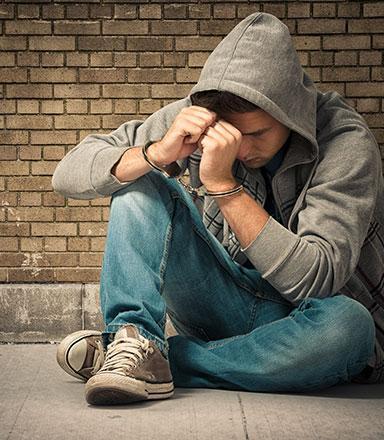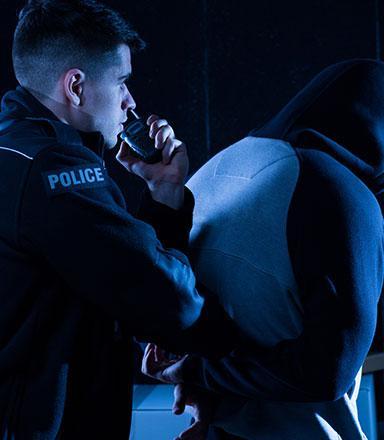Recent Blog Posts
Hate Crimes and Intimidation
 The incidents of several different types of crime rises during the holiday season, likely due to increased stress levels, demands for money, and pervasive societal stress and expectations. Sadly, hate crimes are no exception to these trends. The rate of hate crimes spikes during the holidays both likely due to the aforementioned social quandaries, but also because of the holidays themselves—hate crimes against the Jewish community especially seem to spike during the holiday season, and this even more-so on the East Coast, where cities are comprised of large percentages of citizens who identify with the Jewish faith. In 2015, as terrorist attacks continue to infiltrate the fabric of everyday Western life, the rate of hate crimes against Muslims will likely keep pace as well.
The incidents of several different types of crime rises during the holiday season, likely due to increased stress levels, demands for money, and pervasive societal stress and expectations. Sadly, hate crimes are no exception to these trends. The rate of hate crimes spikes during the holidays both likely due to the aforementioned social quandaries, but also because of the holidays themselves—hate crimes against the Jewish community especially seem to spike during the holiday season, and this even more-so on the East Coast, where cities are comprised of large percentages of citizens who identify with the Jewish faith. In 2015, as terrorist attacks continue to infiltrate the fabric of everyday Western life, the rate of hate crimes against Muslims will likely keep pace as well.
More Than Faith-Based
Regardless, the highest rate of hate crime incident continues to be racially-motivated, at 47 percent nationwide. Hate crimes motivated by religious identification or sexual orientation are tied at second, each accounting for nearly 19 percent of all reported incidents of hate crimes. In Connecticut, a hate crime does not have to be defined as an act of physical violence or physical action. A hate crime can also be defined as a crime of intimidation, which includes criminal harassment or being threatened. A person can be charged with criminal harassment if the alleged victim can prove that he or she was being repeatedly followed, that the person repeatedly called the person’s place of work or home (either directly or through contacting a mutual acquaintance), or if a person receives threatening letters or emails.
Unlikelihood of Repeat Offenses Leads State to Scale Back Juvenile Sex Offender Registry
 For years, states have been tightening the registry for sex offenders, and this includes juvenile sex offenders. But, as more evidence comes in, some states are starting to rethink how they handle their juvenile cases. Unfortunately, the changes are slow in coming, and this can mean some big issues for some juvenile offenders, even in the state of Connecticut, where juveniles are not typically registered.
For years, states have been tightening the registry for sex offenders, and this includes juvenile sex offenders. But, as more evidence comes in, some states are starting to rethink how they handle their juvenile cases. Unfortunately, the changes are slow in coming, and this can mean some big issues for some juvenile offenders, even in the state of Connecticut, where juveniles are not typically registered.
The Truth about Juvenile Sex Offenders
Early information and thinking on juvenile sex offenders had been originally based on what was known about adult offenders. Over time, it has become clear that juvenile offenders and adult offenders are very different. For example, juvenile offenders are far less likely to reoffend than adults, especially if they receive quality treatment and intervention. In fact, some studies have found recidivism rates to be as low as one percent among juvenile offenders.
Assaults Against Police Officers
 In the wake of several headline-making events this year involving police brutality and allegations of systemic issues of bias by police departments, the issue of assaults perpetrated against police have somewhat taken a backseat in media coverage. This does not mean that they are not still happening, or that the issue is not a major one for most police departments across the country. In 2014, more than 48,000 police officers nationwide were assaulted, and of these more than 28 percent sustained injuries. This is a rate of officer assaults of nine per 100 sworn police officers.
In the wake of several headline-making events this year involving police brutality and allegations of systemic issues of bias by police departments, the issue of assaults perpetrated against police have somewhat taken a backseat in media coverage. This does not mean that they are not still happening, or that the issue is not a major one for most police departments across the country. In 2014, more than 48,000 police officers nationwide were assaulted, and of these more than 28 percent sustained injuries. This is a rate of officer assaults of nine per 100 sworn police officers.
Dangerous Interactions
The majority of assaults against police are perpetrated when a person is out of control, either on drugs or drunk or angry. This can happen in a heated emotional or tense situation when the police are called to handle someone who is posing a danger to himself or people around him. When the situation escalates to violence, police officers are sometimes caught in the middle and assaulted, either accidentally or on purpose. Whether the assault against an officer was intended or not does not matter in the eyes of the law.
An Overview of Hate Crime
 When one is accused or charged with a hate crime, in many cases, it becomes a case handled by the Bureau of Federal Investigation (FBI). Hate crimes can vary in severity, meaning that any crime from murder to petty vandalism can be considered as such.
When one is accused or charged with a hate crime, in many cases, it becomes a case handled by the Bureau of Federal Investigation (FBI). Hate crimes can vary in severity, meaning that any crime from murder to petty vandalism can be considered as such.
What is a Hate Crime?
Any crime committed with an element of bias, against a person or a property associated with a race, religion, disability, ethnic origin, or sexual orientation can be considered a hate crime. To hate someone or a group of people is not, by any means, a crime, and is protected by the freedom of speech and other civil liberties laid out in the Bill of Rights. Yet when crime is motivated by this hate, it becomes a serious crime and, in many cases, felony. While not all hate crimes will be considered a federal offense and thus investigated by the FBI, very often the federal government does divert federal resources for the investigation and prosecution of hate crimes.
Governor Proposes Changes to State's Bail System
 Suggested overhauls on the prison system are sweeping the nation, with some proposing reforms to sentencing and others suggesting changes in parole options. In Connecticut, Governor Dannel P. Malloy is taking a different approach by calling for a change to the state’s bail system for charged but not convicted prisoners.
Suggested overhauls on the prison system are sweeping the nation, with some proposing reforms to sentencing and others suggesting changes in parole options. In Connecticut, Governor Dannel P. Malloy is taking a different approach by calling for a change to the state’s bail system for charged but not convicted prisoners.
Connecticut Already Ahead of the Curve
While many states have only just started to consider reform for nonviolent offenders, Governor Malloy has already passed a Second Chance initiative. Designed to reduce penalties for many drug offenders, the bill is aimed at successfully reintegrating nonviolent offenders back into society where they can potentially become productive workers. But the Governor is not satisfied just yet; to truly make an impact on the state’s economic state, he wants to change the bail system for prisoners awaiting sentencing.
Recent Law Enforcement Meeting Aimed at Bettering the Juvenile Justice System
 In the early 1990s, the juvenile justice system was at its worst. Adolescents, many as young as 16, were being tried as adults, and even those that were not lived in overcrowded, unsanitary facilities that were harsh and overly punitive. Thankfully, the system has learned a lot about juvenile crime over the years, and has responded in a positive way. But there is still more to be done. A recent meeting in Washington D.C., attended by New Haven’s police chief, may be an important step to making those changes happen.
In the early 1990s, the juvenile justice system was at its worst. Adolescents, many as young as 16, were being tried as adults, and even those that were not lived in overcrowded, unsanitary facilities that were harsh and overly punitive. Thankfully, the system has learned a lot about juvenile crime over the years, and has responded in a positive way. But there is still more to be done. A recent meeting in Washington D.C., attended by New Haven’s police chief, may be an important step to making those changes happen.
Former Issues Within the Juvenile Justice System
Of all the states in the U.S., Connecticut had probably one of the worst juvenile justice divisions. Teens were routinely arrested and locked into unsafe facilities with little to no hope of rehabilitation or treatment. Many were never even accused, let alone convicted of serious crimes, and 16- and 17-year-olds were tried in adult courts with open records and placed in adult prisons. In effect, the Connecticut juvenile justice system was flooded with uneducated teens that were unlikely to ever find productive jobs or become contributing members of society.
Those Accused of Sexual Assault on Campus May Not Receive Fair Hearing
 The issue of sexual assault on college campuses has been blown out of the shadows in recent years with several high-profile cases. In April of this year, Vice President Joe Biden spoke to the successes that college communities have had in recent years in curbing the number of sexual assaults, but noted that there was far more work to do.
The issue of sexual assault on college campuses has been blown out of the shadows in recent years with several high-profile cases. In April of this year, Vice President Joe Biden spoke to the successes that college communities have had in recent years in curbing the number of sexual assaults, but noted that there was far more work to do.
While in past years, statistics and reports often found that students who were accused of sexual assault faced little to no reprimand by university authorities — while the lives of victims were often thrown into psychological and social upheaval — according to research in 2015, the pendulum may be swinging too far the other way. That is, in an effort to stay out of headlines and attack the issue of sexual assault head on, some university authorities have begun to take accusations of sexual assault as fact, without doing due diligence to back up these accusations. And the accused often faces severe punishments without fair investigation.
Is There a Correlation between Crime and Casinos?
 Casinos have long been touted as dangerous to a community for the rise in crime with which they are associated in surrounding areas. Casinos are also associated with a rise in tourism and employment opportunities, so most communities tend to vote in favor of their construction and take the risk.
Casinos have long been touted as dangerous to a community for the rise in crime with which they are associated in surrounding areas. Casinos are also associated with a rise in tourism and employment opportunities, so most communities tend to vote in favor of their construction and take the risk.
Some studies show that the ratio of available jobs to area adult residents increased by as much as 5 percent. Yet other studies show that the presence of casinos is also associated with an increase in area substance abuse, mental illness, violent crime, theft, bankruptcy, and even increasing suicide rates. Some communities report a 10 percent increase in larceny, bankruptcy, and auto theft after an area casino opened.
It was more than 20 years ago that communities of Connecticut decided to take this risk, and the past two decades have shown that Connecticut may be the exception when it comes to these statistics. In fact, crime rates have decidedly fallen since two of the state’s largest casinos — Foxwoods Resort and Mohegan Sun — opened.
Does Driving under the Influence with Minors in the Car Lead to Additional Charges in Connecticut?
 Drunk driving in Connecticut is not worth the cost, or the risk. Sadly, the percentage of Connecticut drivers who admit to driving after drinking too much is still higher than the national average. Even more concerning is that an alarming number of parents get behind the wheel, drunk, with their children in the car. Whether they are aware of it or not, this could lead to additional charges, regardless of there not being an official law covering driving under the influence with minor passengers.
Drunk driving in Connecticut is not worth the cost, or the risk. Sadly, the percentage of Connecticut drivers who admit to driving after drinking too much is still higher than the national average. Even more concerning is that an alarming number of parents get behind the wheel, drunk, with their children in the car. Whether they are aware of it or not, this could lead to additional charges, regardless of there not being an official law covering driving under the influence with minor passengers.
Even at First Offense, DUI Laws Are Costly
Connecticut has cracked down on drunk driving over the years; now, even on a first DUI offense, your license can be suspended and you may spend anywhere from six months to a year with an Ignition Interlock Device (IID) on your vehicle. Each additional offense increases the level of consequences, and if you are charged enough, you could face serious criminal charges.
Connecticut Criminal Consequences of Teen Sexting
 Youth in every society, from the beginning of time, have pushed boundaries, and explored their sexuality. Today’s teenagers are no different. But, the consequences of their actions can now be recorded and distributed through smart phones and published on the web for the world to see. Connecticut has developed a set of laws to deal specifically with youth under age 18 who engage in sexting.
Youth in every society, from the beginning of time, have pushed boundaries, and explored their sexuality. Today’s teenagers are no different. But, the consequences of their actions can now be recorded and distributed through smart phones and published on the web for the world to see. Connecticut has developed a set of laws to deal specifically with youth under age 18 who engage in sexting.
Sexting and Child Pornography
The law in Connecticut makes it illegal for anyone under 18 and at least 13 years old to possess or transmit sexually explicit images, through a computer or mobile phone, of anyone between the ages of 13 and 16 years old. Here are some examples of how the law works:
- A 17-year old takes naked picture of her 15 year old boyfriend with her phone. She has committed a crime.







